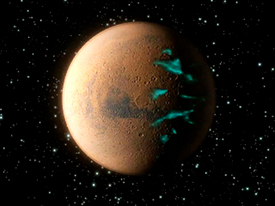Mars Express science highlights:
#7. Discovery of localised auroras on Mars
On Earth, auroras are spectacular, often colourful, displays that are regularly seen in the night sky above the polar regions. On our planet, as well as on the giant planets Jupiter, Saturn, Uranus and Neptune, they occur where the planetary magnetic field lines approach the surface near the poles. The emissions of light are produced by charged particles (electrons, protons or ions) in the solar wind travelling down the field lines and colliding with gaseous molecules or atoms in the upper atmosphere.
Unlike these planets, Mars does not have a global magnetic field, although NASA’s Mars Global Surveyor discovered magnetic anomalies in the crust, which seem to be the remnants of an old planetary magnetic field. This led to speculation that the Red Planet might display auroral phenomena.
 |
|
Artist's impression of localised aurora above Mars Credit: ESA - C. Carreau |
This hypothesis was proved to be correct when SPICAM detected light emissions during night-time observations of the southern hemisphere. The total size of the emission region was about 30 km across, and possibly located at an altitude of about 150 km. The detected emission indicated that the upper atmosphere was being excited by fluxes of charged particles – probably electrons.
By analysing the map of crustal magnetic anomalies compiled from Mars Global Surveyor’s data, scientists noticed that the region of the emissions corresponded to the area where the strongest magnetic field is found.
The SPICAM observations provided for the first time a key insight into the role of the martian crustal magnetic field in producing cusp-like magnetic structures. These structures concentrate fluxes of electrons into small regions of the martian atmosphere. Eventually, they induce the formation of faint and localised mid-latitude auroras.
Over the following months and years, SPICAM provided more detailed evidence of auroras above the night side of Mars, especially where there are localised enhancements of the crust’s magnetism. Such localised emissions are unique in the Solar System. The energy flux of the precipitating particles would create auroras of weak or medium intensity at Earth.
Further supporting evidence was provided by observations from the ASPERA-3 instrument, which revealed inverted, V-shaped structures of accelerated electrons and ions above the night side of Mars that are almost identical to those that occur above auroras on Earth. The particle acceleration was discovered to occur mainly in a region close to local midnight.
